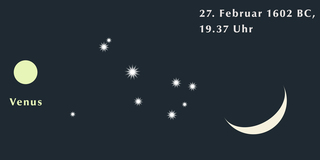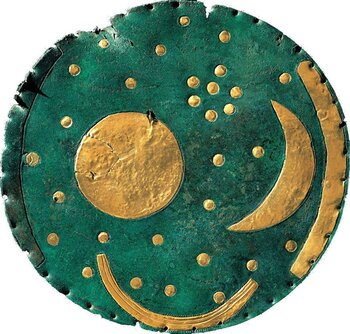Internationale prijsvraag
Wanneer Venus en avondsikkel bij het Zevengesternte?
De Deense astronoom Søren Toft had december 2019 ter ere van "Venus in grootste glans bij de Plejaden april 2020" een internationale prijsvraag ontworpen.
Vanuit de Mathematisch-Astronomische Sektion aan het Goetheanum in Dornach (Zwitserland) kregen sterrenliefhebbers de volgende vragen:
Vraag 1: Wanneer bereikt Venus in het voorjaar van 2020 het Zevengesternte?
In de "Sternen- und Planetenkalender 2020" (Verlag Urachhaus) publiceerde Liesbeth Bisterbosch het hemelbeeld van 27 februari 1602 v.Chr. (dat is in het jaar - 1601). 's Avonds schitterde het Zevengesternte tussen Venus en de maansikkel.

Vraag 2: Hoe ver waren Venus en de maansikkel op dat moment van Alcyone? Alcyone is de helderste ster in de Pleiaden. Bepaal a.u.b. de hoekafstand om 19.00 uur en kies als locatie Mittelberg in Duitsland, waar de hemelschijf van Nebra gevonden is (51 ° N, 12 ° E).
Ze vergeleek dit hemelbeeld met de hemelschijf van Nebra.

© LDA Sachsen-Anhalt, Foto: Juraj Lipták
Zijn er veel van zulke fraaie samenstanden? Of is het een zeer zeldzaam fenomeen? We houden deze wedstrijd om licht te werpen op deze vraag.
Vraag 3: Zijn er in de periode vanaf 2100 v. Chr. tot 2100 na Chr. overeenkomstige nauwe samenstanden van Venus, Maan en de Plejaden?
Het gaat erom te achterhalen op welke dagen Venus en de maan minder dan 3 graden verwijderd zijn van Alcyone. Vanaf Nebra (51° N, 12° E) is het trio aan de avondhemel een indrukwekkend verschijnsel.
Deze derde vraag is voor mensen die een uitdaging zoeken!
2020-03-24
https://de.wikipedia.org/wiki/Himmelsscheibe_von_Nebra
Joachim Schultz: Rhythmen der Sterne, Verlag am Goetheanum (1963)
Conclusion
The advanced question was this
"Is there in the period from 2100 BC to 2100 AD other beautiful meetings between Venus, the Moon and Alcyone (the central star of the Pleiades) than the one mentioned above.
"Beautiful meetings" (or I7M3 meetings) here means that the distance from Venus to Alcyone and the distance from the Moon to Alcyone simultaneously are less than 3 degrees, and that it can be seen in the evening sky from where the Nebra-sky-disk was found, Mittelberg (DE) [51 ° 17 'N + 11 ° 31' E] "
The question is still open, but to our present knowledge the following dates
are found:
BC 1730-03-03 Liesbeth Bisterbosch
BC 1602-02-27 Liesbeth Bisterbosch
BC 1543-03-05 Sophia Gustafsson
BC 1041-03-05 Klaus Marheineke
AD 183-03-14 Klaus Marheineke
AD 335-03-14 Klaus Marheineke
AD 1542-03-20 Søren Toft
AD 2044-04-01 John Meeks
It is obviously a rather seldom situation
that Venus, Moon and the 7-Star
are seen simultaneous on the evening sky.
When the mentioned solutions are visualized on the computer-screen, no constellation is as beautiful as the one proposed by Liesbeth Bisterbosch BC1602 (or year -1601).
2020-04-28
Søren Toft
Wings
These dates can be regarded as case-studies to the theoretical question, but they present in no way the complete solution.
The ‚simple‘ question is “What is the distance from Alcyone to Moon and Venus at a certain time t “ (eg. BC1602-02-27) . Its answer can be formulated and reduced to a real function f(t), where t is the time (in Julian Date) f(t) = max { the angular distance (in degrees) from Alcyone to the Moon; the angular distance (in degrees) from Alcyone to Venus}
This question can be solved with several modern computer programs and apps ( eg. Cartes du Ciel).
The inverse question is to solve the equation f(t)< 3
This is a harder question involving the inverse function f-1(x)
The dates above gives a phenomenological starting-point for the mathematical astronomical question proposed here.
Søren Toft
Zie voor meer informatie de website van Søren Toft



